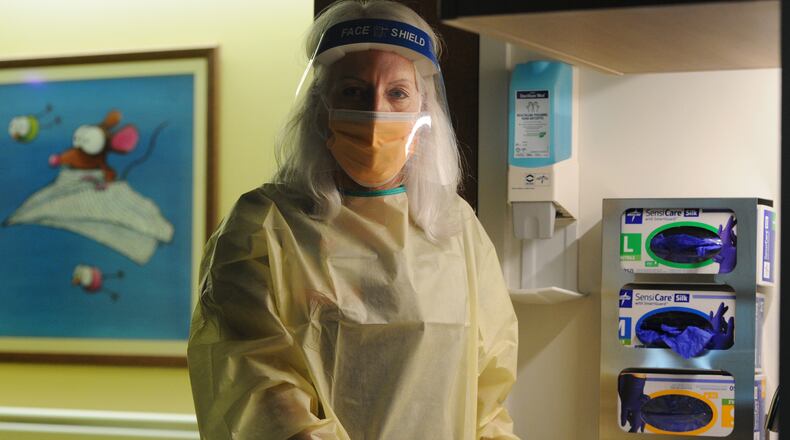“The most difficult part is when you get to the point where you feel helpless, like you can’t really help them anymore … We have tools, we tried them all, but we came up short because there’s a point in this disease where whatever you do is not going to work,” Ali said. “And that was very difficult to watch, his wife crying and to watch his oxygen saturation dropping slowly until he passed away.”
Dayton-area health care workers on the front lines of treating COVID-19 patients became increasingly depressed and frustrated as they watched a fourth wave of COVID sweep across the area, with cases and deaths mounting in recent months.
Credit: JIM NOELKER
Credit: JIM NOELKER
This year, 1,086 people have died of COVID-19 in Montgomery, Greene, Warren and Miami counties, according to Ohio Department of Health data. Unvaccinated Ohioans have made up 98% of statewide COVID-19 deaths in 2021, according to the Ohio Department of Health.
“The first year was difficult,” Ali said. “After January, when we had the vaccine, it was more depression because a lot of people we lost, we felt like this is preventable loss.”
After treating coronavirus patients for going on 20 months, hospital staff see no end in sight as they face a younger patient population and increasing abuse from those who embrace misinformation and view them as the enemy. This is on top of the stressful conditions they have endured throughout the pandemic, like wearing personal protective equipment for long hours, the fear of taking the virus home, less than optimal staffing levels and working extra shifts to care for the large influx of high-need patients.
Health care workers exhausted, burned out
As of Friday, 269 inpatients in the Dayton region had COVID-19. At the peak of the current surge, just over 400 hospitalized patients in the region had COVID-19. Even as this fourth wave abates somewhat, workers treating coronavirus patients are still overwhelmed and fearful of more waves.
Vicki Laywell, a respiratory therapist at Kettering Medical Center, said it feels like they’re in a war zone.
“We’re fighting this battle and it just keeps coming and coming,” Laywell said. “I feel like if the public could go through a COVID ICU and see what these people are dealing with, it would change their perspective on wearing masks, getting vaccinated, hand washing, limiting your inner circle of family and friends. You want to be around next year and if you get this COVID … there’s so many that are not surviving, and when they do survive, sometimes they have lifetime altered changes to their physical health.”
Patricia O’Malley, a nurse researcher at Premier Health, said coronavirus has turned hospitals into field hospital-like environments.
“We know that continuous exposure to all of this high acuity over this period of time does result in moral distress, moral suffering, anxiety, exhaustion and sadness,” O’Malley said. “And the idea that so much of what we are seeing now with our unvaccinated population is unnecessary is particularly difficult.”
A nationwide survey of more than 5,000 registered nurses released last month by National Nurses United, found that about 42% of nurses feel sad or depressed more often than they did before the pandemic, and more than a third feel traumatized by their experiences caring for patients.
“Too many tasks, too little time for self care, too much stress,” said Bernadette Melnyk, dean of the Ohio State University College of Nursing. “And all of that is affecting our nurses, physicians and other health care workers, and it’s compromising quality and safety of care.”
Sable Morgan, a nurse team leader in the intensive care unit at Miami Valley Hospital, was feeling so burned out that she went from full-time to part-time in February.
“Dealing with the amount of death that we’re seeing, it really takes a toll on you,” Morgan said. “It’s emotional because no matter how hard we fight, it’s just kind of a never-ending fight. It’s exhausting. It’s not seeing the light at the end of the tunnel that makes it the hardest …And it was kind of, I need to step down a little bit or I don’t know if I can keep nursing.”
Credit: William J Jones
Credit: William J Jones
Misinformation and abuse
“We get a lot of hate, we get a lot of bullying, we get a lot of people yelling at us, and it’s all political,” said Kelly Schlotterbeck, a respiratory therapist working at The Christ Hospital in Cincinnati and Miami Valley South.
Schlotterbeck and other area health care workers said the number of patients asking for dangerous, untested treatments they saw online has gotten out of control.
“Somebody asked if we could nebulize hydrogen peroxide because apparently there’s a TikTok video where somebody says that nebulizing hydrogen peroxide will help COVID,” she said. “That would be incredibly dangerous, it’s a free radical. It is completely not recommended. And these are the things that people are asking for. I’ve had people tell us, ‘You’re not doing enough to help me.’”
She said another patient treated by a colleague refused a badly needed blood transfusion unless the staff could prove the blood came from a donor who was not vaccinated against COVID-19.
“What worries me is the amount of distrust from the public,” Schlotterbeck said. “An opinion is not an expert’s opinion. And I feel like the public anymore thinks that because they’ve read it, they can demand what happens in their care, no matter how ludicrous it is, and I am really concerned as to when this is going to stop.”
Nurses and other health care workers were revered as heroes at the beginning of the pandemic, Morgan said, but now they’re treated like the enemy for encouraging vaccination.
The National Nurses United survey found that 31% of hospital nurses had faced workplace violence, up from 22% in their March survey.
People’s fears about vaccines and the virus are valid, O’Malley said, but misinformation — especially the belief that natural immunity is enough or an untested substance will treat coronavirus — is a threat to public health.
Patients hospitalized with COVID-19 and their families are understandably desperate for anything to give them hope, Laywell said.
“And it’s so sad, because the vaccine is the hope that they should have turned to before,” said Laywell as she choked back tears. “It just became such a political situation, and it’s when you’re up there, you see people gasping for breath and trying to decide, ‘Should I go on a ventilator because I probably won’t wake up,’ there’s nothing political about it.”
Patients leave forever changed
Area hospital workers warn that even the patients who survive COVID-19 hospitalization are forever changed by the experience. The reality further depresses staff as many cases of patients saved don’t feel like a victory.
“People are constantly talking about the 99% survival rate,” Schlotterbeck said. “I really wish that the public realized that even the people that leave on oxygen, or awaiting lung transplants or leave on dialysis with chronic kidney disease afterward, they’re included in that 99%. But their life is going to be so impacted.”
Never able to work again. Remaining on ventilators the rest of their lives. Never walking again.
“I wish that the public knew more of that,” Schlotterbeck said. “I had a patient last night that’s been there for like four months. He’s COVID resolved but he’s still on a ventilator, and we’re having a hard time getting him off.””
Chronic symptoms like brain fog, shortness of breath, loss of taste and smell can last a long time after contracting COVID-19, Ali said.
“I still see in my pulmonary clinic a good number of these patients who have scar tissue in their lungs,” he said.
A study from June found that 45% of patients hospitalized for COVID-19 still suffered related health issues when they were discharged.
Karen Davis, a nurse in the intensive care unit at Dayton Children’s Hospital, said being hospitalized for COVID-19 is a life-changing experience for children.
“The patients that I took care of, the youngest was 9 and the oldest was 17. They all had trouble breathing,” she said. “The one that stands out to me the most was a young man that was 17, and I took care of him in the beginning phase of his disease process. And it was just hard to watch him … he got very anxious because he couldn’t breathe, and I’m trying to tell him ‘Try to slow your breathing down.’ The whole time I knew he couldn’t breathe. It’s just hard to watch them struggle … They become aware of their own mortality, and that’s a little young to be aware of that.”
Have questions about COVID-19, face masks, vaccines, testing, quarantining or anything else pandemic-related? Send them to jordan.laird@coxinc.com. Answers will be published regularly in print and online.
About the Author





